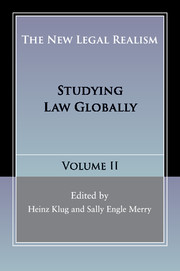Book contents
- Frontmatter
- Dedication
- Contents
- List of contributors
- Preface to The New Legal Realism, Volumes I and II
- 1 Introduction
- Section I The Globalization of Law
- Section II The Global Transfer of Norms
- 5 Colonizing the Clinic: The Adventures of Law in HIV Treatment and Research
- 6 The Politics of Islamic Law and Human Rights: Sudan's Rival Legal Systems
- 7 Women Seeking Justice At the Intersection Between Vernacular and State Laws and Courts in Rural KwaZulu-Natal, South Africa
- Section III global institutions and the changing roles of judges and lawyers
- Section IV Global Justice
- Index
- References
7 - Women Seeking Justice At the Intersection Between Vernacular and State Laws and Courts in Rural KwaZulu-Natal, South Africa
from Section II - The Global Transfer of Norms
Published online by Cambridge University Press: 05 May 2016
- Frontmatter
- Dedication
- Contents
- List of contributors
- Preface to The New Legal Realism, Volumes I and II
- 1 Introduction
- Section I The Globalization of Law
- Section II The Global Transfer of Norms
- 5 Colonizing the Clinic: The Adventures of Law in HIV Treatment and Research
- 6 The Politics of Islamic Law and Human Rights: Sudan's Rival Legal Systems
- 7 Women Seeking Justice At the Intersection Between Vernacular and State Laws and Courts in Rural KwaZulu-Natal, South Africa
- Section III global institutions and the changing roles of judges and lawyers
- Section IV Global Justice
- Index
- References
Summary
Introduction
The Traditional Courts Bill (TCB) is a piece of legislation drafted by the South African Department of Justice and Constitutional Development and introduced in 2008 to regulate customary courts and provide better access to justice for the 16 to 21 million South Africans living in rural areas (Claassens 2011; Mnisi Weeks 2012). Several problems have been raised with the legislation (Claassens 2011; Mnisi Weeks 2012). These include its having been drafted without consulting ordinary rural people, especially women, who make up 59 per cent of the rural population (Budlender, as cited in Claassens and Cousins 2008, 2n2, 168n22). Only traditional leaders and local government were properly consulted (Traditional Courts Bill, B15-2008 and later B1-2012, ‘Memorandum to the Bill’, clause 4).
The resultant substantive problems include a lack of adequate protections for women and their rights (Mnisi Weeks 2012n2). Two main examples are pertinent. Firstly, in the Bill, women are not guaranteed self-representation in traditional courts. Secondly, the Bill does not attempt to make women members of traditional courts or ensure their participation in decision making, and thus does not conceive of their participation beyond their being mere litigants. One argument would say that the constitutional right to gender equality (Constitution of South Africa, section 9(3)) would require that the Bill make these accommodations. This argument has been made repeatedly by opponents of the Bill.
Aside from the Constitution, however, empirically-based lawmaking practice would also seem to demand that such provisions be included in the Bill. After all, among the problems put to the South African Law Reform Commission (SALRC), when it conducted its research and consultations in 1998–2003 (SALRC 2003), was the fact that in many rural areas women were not allowed to speak or represent themselves – they could only be represented by male relatives (18). This presented particular difficulties for women in mourning who, though they were also uniquely vulnerable to eviction by family members at this time, also faced restrictions on their ability to be seen in public and hence could not attend court hearings (Claassens and Ngubane 2008; Burman, Carmody, and Hoffman-Wanderer 2008; Claassens and Mnisi 2009; Mnisi Weeks 2011a, 2013). These women are required to be represented by male relatives who are, in some instances, the very ones seeking to dispossess them (ibid.).
- Type
- Chapter
- Information
- The New Legal RealismStudying Law Globally, pp. 113 - 142Publisher: Cambridge University PressPrint publication year: 2016



